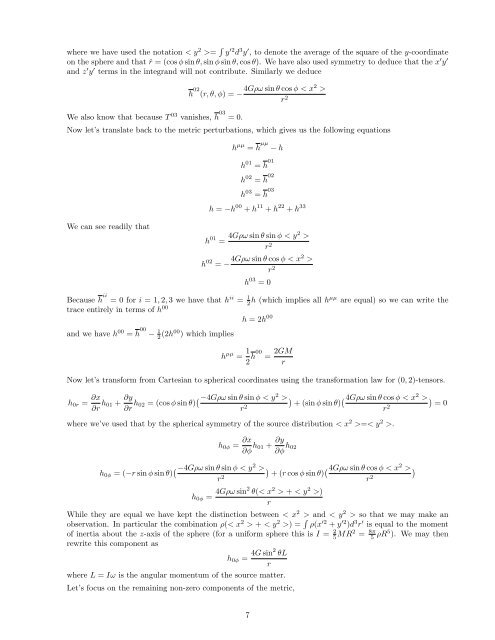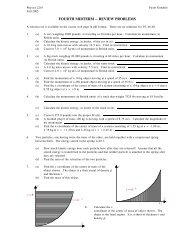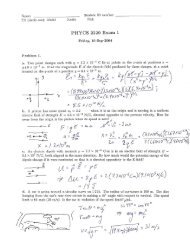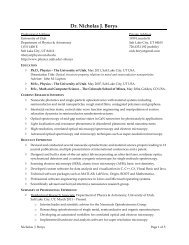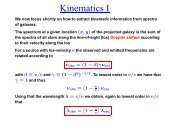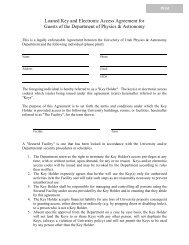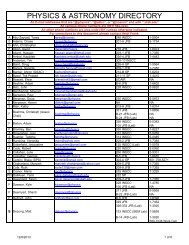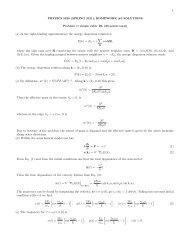General Relativity: Homework 4 Solutions - Department of Physics ...
General Relativity: Homework 4 Solutions - Department of Physics ...
General Relativity: Homework 4 Solutions - Department of Physics ...
You also want an ePaper? Increase the reach of your titles
YUMPU automatically turns print PDFs into web optimized ePapers that Google loves.
where we have used the notation < y 2 >= ∫ y ′2 d 3 y ′ , to denote the average <strong>of</strong> the square <strong>of</strong> the y-coordinate<br />
on the sphere and that ˆr = (cos φ sin θ, sin φ sin θ, cos θ). We have also used symmetry to deduce that the x ′ y ′<br />
and z ′ y ′ terms in the integrand will not contribute. Similarly we deduce<br />
We also know that because T 03 vanishes, h 03 = 0.<br />
h 02 (r, θ, φ) = − 4Gρω sin θ cos φ < x2 ><br />
r 2<br />
Now let’s translate back to the metric perturbations, which gives us the following equations<br />
h µµ = h µµ − h<br />
h 01 = h 01<br />
h 02 = h 02<br />
h 03 = h 03<br />
h = −h 00 + h 11 + h 22 + h 33<br />
We can see readily that<br />
h 01 = 4Gρω sin θ sin φ < y2 ><br />
r 2<br />
h 02 = − 4Gρω sin θ cos φ < x2 ><br />
r 2<br />
h 03 = 0<br />
Because h ii = 0 for i = 1, 2, 3 we have that h ii = 1 2 h (which implies all hµµ are equal) so we can write the<br />
trace entirely in terms <strong>of</strong> h 00 h = 2h 00<br />
and we have h 00 = h 00 − 1 2 (2h00 ) which implies<br />
h µµ = 1 2 h00 = 2GM<br />
r<br />
Now let’s transform from Cartesian to spherical coordinates using the transformation law for (0, 2)-tensors.<br />
h 0r = ∂x<br />
∂r h 01 + ∂y<br />
∂r h 02 = (cos φ sin θ) ( −4Gρω sin θ sin φ < y 2 ><br />
r 2 )<br />
+ (sin φ sin θ)<br />
(4Gρω sin θ cos φ < x 2 ><br />
r 2 )<br />
= 0<br />
where we’ve used that by the spherical symmetry <strong>of</strong> the source distribution < x 2 >=< y 2 >.<br />
h 0φ = ∂x<br />
∂φ h 01 + ∂y<br />
∂φ h 02<br />
h 0φ = (−r sin φ sin θ) ( −4Gρω sin θ sin φ < y 2 > ) (4Gρω sin θ cos φ < x 2 > )<br />
+ (r cos φ sin θ)<br />
r 2 r 2<br />
h 0φ = 4Gρω sin2 θ(< x 2 > + < y 2 >)<br />
r<br />
While they are equal we have kept the distinction between < x 2 > and < y 2 > so that we may make an<br />
observation. In particular the combination ρ(< x 2 > + < y 2 >) = ∫ ρ(x ′2 + y ′2 )d 3 r ′ is equal to the moment<br />
<strong>of</strong> inertia about the z-axis <strong>of</strong> the sphere (for a uniform sphere this is I = 2 5 MR2 = 8π 5 ρR5 ). We may then<br />
rewrite this component as<br />
h 0φ = 4G sin2 θL<br />
r<br />
where L = Iω is the angular momentum <strong>of</strong> the source matter.<br />
Let’s focus on the remaining non-zero components <strong>of</strong> the metric,<br />
7


